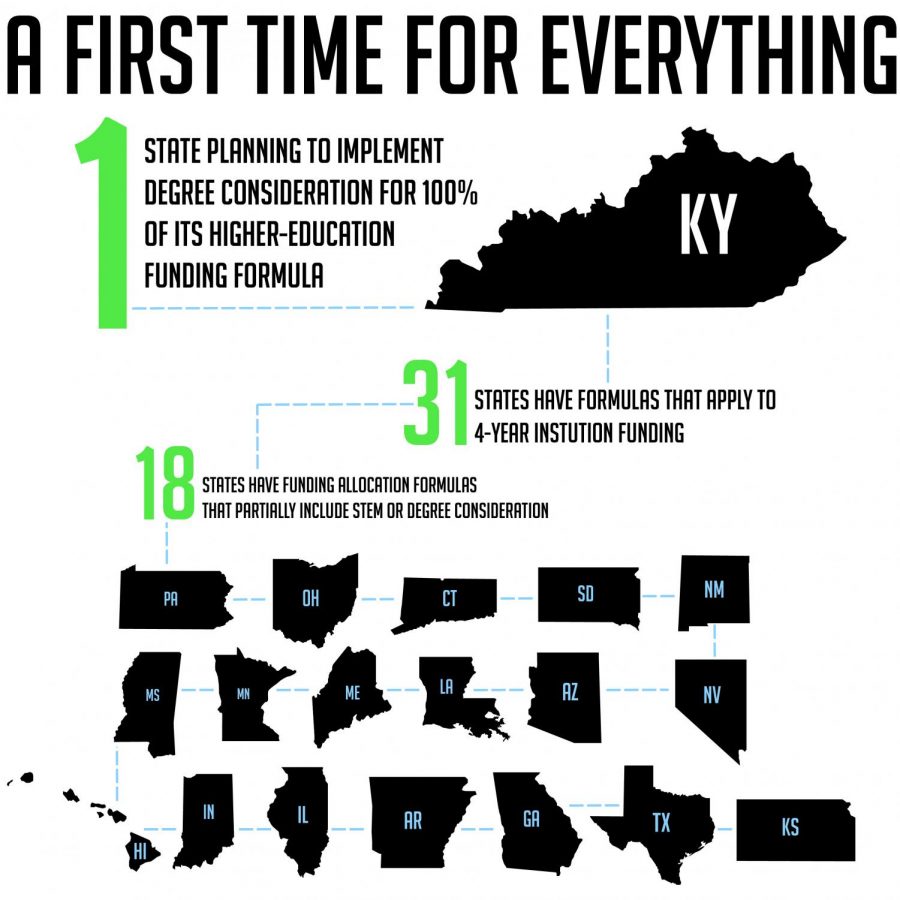Kentucky universities await effects of Bevin’s budget
February 9, 2016
Kentucky will join the ranks of 31 states with existing formulas to allocate university funding based on institutional performance, if Gov. Matt Bevin’s proposed budget is passed in its current form.
Changing state allocations to performance-based models has been a trend for state legislatures across the country in the past decade but with varying results.
The models that each state decided to adopt have core similarities, but each is different.
Under Bevin’s vision, one-third of all allocations will be performance based by fiscal year 2018. The amount of money in the performance pool will increase every year until all funds will be allocated based on performance criteria in fiscal year 2020.
While state universities are still scrambling to manage immediate budget cuts of 4.5 percent this fiscal year, there is also a race to define how performance-based funding will look in the Bluegrass state.
Kentucky’s Council on Postsecondary Education will be busy reviewing the existing funding models of other states so it can prepare options for universities and lawmakers to consider.
Bill Payne, associate vice president for Budget and Finance at the CPE, declined to comment at the time of publication but did confirm that several models from neighboring states were being reviewed.
Bevin’s plans for 100 percent funding by performance and his emphasis on workforce-related education has drawn comparisons to Tennessee’s and Ohio’s current models.
Tennessee’s funding model uses performance metrics to determine how all of the state’s higher education funds will be disbursed, making it similar in that aspect to Bevin’s proposal. But there are key differences.
Debra Sells, vice president for Student Affairs and vice provost for Enrollment and Academic Services at Middle Tennessee State University, explained how the Tennessee funding model affects her school.
“We don’t receive money for outdoing other schools,” Sells said. “We look at our own performance numbers in a year compared over many years to judge our school’s improvement.”
Although Tennessee does use a performance model for its allocations, the state also sets aside money from the budget to cover operating costs before dividing the rest of the funds. Sells said this approach was essential to making the formula work correctly.
“You can’t reduce your costs to nothing, and there are bills to pay in order to keep the school running,” Sells said. “If the governor didn’t add more money to close gaps in the budget, all of the schools would be fighting with each other over one pot of money.”
Comments made by Bevin during his speech imply that his budget plans wouldn’t have this same consideration.
“There is not going to be money just for the sake of existence,” Bevin said during his budget address.
According to a document released from the Kentucky CPE, the CPE has agreed upon metrics similar to those used Tennessee, such as progression rates, graduation rates, amount of degrees and credentials produced and retention. There are also some critical differences.
Sector specific metrics, such as science, technology, engineering and math (STEM) degrees, workforce education and transfers with associate degrees are agreed upon metrics by the council. Tennessee does allocate performance money to schools based on STEM research but not specifically for degrees.
Kentucky’s northern neighbor, Ohio, has included weighted metrics for STEM degrees in its state model, but with a few differences.
Over half of an Ohio institution’s funding is weighted by its degree completion, followed by 30 percent from course completion and 20 percent for doctoral and medical degrees. The STEM metrics play a lesser role, according to Ohio’s postsecondary council website. All of these performance marks are compared to the institution’s numbers over three years, instead of on a yearly basis.
Like in Tennessee, Ohio universities do not compete against each other for performance-based funding.
Bevin’s explanation of his higher education plans during his budget address paint a different picture of the pressure put on skills to participate in STEM and workforce programs.
“The net result of putting public tax dollars into education is to ensure that we are graduating people that can go in the workforce and get out of their parents’ basement, among other things,” Bevin said during his budget address. “If we’re going to subsidize them with taxpayer money, we’re going to focus on the outcomes.”
There has been a lot of activity and discussion among the administration at WKU over the changes the university will face under a performance model, but without any solid answers on how Kentucky’s version will be administered, universities are left waiting.
“Our ability to operate under a funding model where all of the state funding is performance based depends on the final performance metrics and the goal setting,” Ann Mead, senior vice president for Finance and Administration, said in an email Friday afternoon.
Until the budget is approved by the Kentucky legislature and the metrics for the model are decided, university administration will have to continue to speculate and prepare to argue their case.













